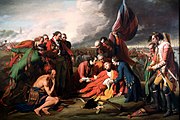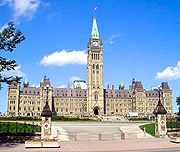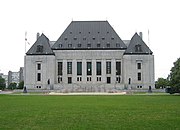Canada (pronounced /ˈkænədə/) is a country occupying most of northern North America, extending from the Atlantic Ocean in the east to the Pacific Ocean in the west and northward into the Arctic Ocean. It is the world's second largest country by total area[7] and shares the world's longest common border with the United States to the south and northwest.
The land occupied by Canada was inhabited for millennia by various groups of Aboriginal people. Beginning in the late 15th century, British and French expeditions explored, and later settled along, the Atlantic coast. France ceded nearly all of its colonies in North America in 1763 after the Seven Years' War. In 1867, with the union of three British North Americancolonies through Confederation, Canada was formed as a federal dominion of four provinces.[8][9][10] This began an accretion of provinces and territories and a process of increasing autonomy from the United Kingdom. This widening autonomy was highlighted by the Statute of Westminster of 1931 and culminated in the Canada Act of 1982, which severed the vestiges of legal dependence on the British parliament.
A federation comprising ten provinces and three territories, Canada is a parliamentary democracy and a constitutional monarchy, with Queen Elizabeth II as its head of state. It is abilingual and multicultural country, with both English and French as official languages both at the federal level and in the province of New Brunswick. Technologically advanced and industrialized, Canada has a diversified economy reliant upon its abundant natural resources and upon trade—particularly with the United States, with which Canada has had a long andcomplex relationship. It is a member of the G8, NATO, OECD, WTO, the Commonwealth of Nations, the Francophonie, the OAS, APEC, and the United Nations.
Contents[hide] |
Etymology
The name Canada comes from a St. Lawrence Iroquoian word,kanata, meaning "village" or "settlement". In 1535, indigenous inhabitants of the present-day Quebec City region used the word to direct French explorer Jacques Cartier towards the village ofStadacona.[11] Cartier later used the word Canada to refer not only to that particular village, but also the entire area subject toDonnacona (the chief at Stadacona); by 1545, European books and maps had begun referring to this region as Canada.[12]
From the early 17th century onwards, that part of New Francethat lay along the Saint Lawrence River and the northern shores of the Great Lakes was named Canada, an area that was later split into two British colonies, Upper Canada and Lower Canada, until their re-unification as the Province of Canada in 1841. UponConfederation in 1867, the name Canada was adopted as the legal name for the new country,[13] and Dominion was conferred as the country's title;[14] combined, the termDominion of Canada was in common usage until the 1950s. Thereafter, as Canada asserted its political autonomy from Britain, the federal government increasingly used simply Canadaon state documents and treaties, a change that was reflected in the renaming of the national holiday from Dominion Day to Canada Day in 1982.[15]
History
First Nation and Inuit traditions maintain that indigenous people have resided on their lands since the beginning of time, while archaeological studies support a human presence in the northern Yukon from 26,500 years ago, and in southern Ontario from 9,500 years ago.[16][17]Europeans first arrived when the Vikings settled briefly atL'Anse aux Meadows around AD 1000; following the failure of that colony, there was no further attempt at North American exploration until 1497, when John Cabotexplored Canada's Atlantic coast for England,[18] followed by Jacques Cartier in 1534 forFrance.[19]
French explorer Samuel de Champlain arrived in 1603 and established the first permanent European settlements at Port Royal in 1605 and Quebec City in 1608. Among French colonists of New France, Canadiens extensively settled the Saint Lawrence River valley, Acadians settled the present-day Maritimes, while French fur traders and Catholic missionaries explored the Great Lakes, Hudson Bay, and the Mississippi watershed to Louisiana. The French and Iroquois Wars broke out over control of the fur trade.
The English established fishing outposts in Newfoundland around 1610 and colonized the Thirteen Colonies to the south. A series of fourIntercolonial Wars erupted between 1689 and 1763. Mainland Nova Scotia came under British rule with the Treaty of Utrecht (1713); the Treaty of Paris (1763) ceded Canada and most of New France to Britain following the Seven Years' War.
The Royal Proclamation (1763) carved the Province of Quebec out of New France and annexed Cape Breton Island to Nova Scotia. It also restricted the language and religious rights of French Canadians. In 1769, St. John's Island (now Prince Edward Island) became a separate colony. To avert conflict in Quebec, theQuebec Act of 1774 expanded Quebec's territory to the Great Lakes and Ohio Valley and re-established the French language, Catholic faith, and French civil law in Quebec; it angered many residents of the Thirteen Colonies, helping to fuel the American Revolution.[20] The Treaty of Paris (1783) recognized American independence and ceded territories south of the Great Lakes to the United States. Approximately 50,000United Empire Loyalists fled the United States to Canada.[21] New Brunswick was split from Nova Scotia as part of a reorganization of Loyalist settlements in the Maritimes. To accommodate English-speaking Loyalists in Quebec, the Constitutional Act of 1791 divided the province into French-speaking Lower Canadaand English-speaking Upper Canada, granting each their own elected Legislative Assembly.
Canada (Upper and Lower) was the main front in the War of 1812 between the United States and the British Empire. The defence of Canada contributed to a sense of unity among British North Americans. Large-scale immigration to Canada began in 1815 from Britain and Ireland. Thetimber industry surpassed the fur trade in importance in the early nineteenth century.
The desire for responsible government resulted in the aborted Rebellions of 1837. The Durham Reportsubsequently recommended responsible government and the assimilation of French Canadians into British culture.[22] The Act of Union 1840 merged The Canadas into a United Province of Canada. French and English Canadians worked together in the Assembly to reinstate French rights. Responsible government was established for all British North American provinces by 1849.[23][24]
The signing of the Oregon Treaty by Britain and the United States in 1846 ended the Oregon boundary dispute, extending the border westward along the 49th parallel and paving the way for British colonies onVancouver Island (1849) and in British Columbia (1858). Canada launched a series of western exploratory expeditions to claim Rupert's Land and the Arctic region. The Canadian population grew rapidly because of high birth rates; British immigration was offset by emigration to the United States, especially by French Canadians' moving to New England.
Following several constitutional conferences, the Constitution Act, 1867 brought about Confederation creating "one Dominion under the name of Canada" on July 1, 1867, with four provinces: Ontario, Quebec,Nova Scotia, and New Brunswick.[25] Canada assumed control of Rupert's Land and the North-Western Territory to form the Northwest Territories, where the Métis' grievances ignited the Red River Rebellion and the creation of the province of Manitoba in July 1870. British Columbia and Vancouver Island (which hadunited in 1866) and the colony of Prince Edward Island joined the Confederation in 1871 and 1873, respectively.
Prime Minister John A. Macdonald's Conservative government established a national policy of tariffs to protect nascent Canadian manufacturing industries. To open the West, the government sponsored construction of three trans-continental railways (most notably the Canadian Pacific Railway), opened the prairies to settlement with the Dominion Lands Act, and established the North-West Mounted Police to assert its authority over this territory. In 1898, after the Klondike Gold Rush in the Northwest Territories, the Canadian government created the Yukon territory. Under Liberal Prime Minister Wilfrid Laurier, continental European immigrants settled the prairies, and Alberta and Saskatchewan became provinces in 1905.
Canada automatically entered World War I in 1914 with Britain's declaration of war, sending volunteers to the Western Front, who later became part of the Canadian Corps. The Corps played a substantial role in theBattle of Vimy Ridge and other major battles of the war. The Conscription Crisis of 1917 erupted when conservative Prime Minister Robert Borden brought in compulsory military service over the objection of French-speaking Quebecers. In 1919, Canada joined the League of Nations independently of Britain; in 1931, the Statute of Westminster affirmed Canada's independence.
The Great Depression brought economic hardship to all of Canada. In response, the Co-operative Commonwealth Federation (CCF) in Alberta and Saskatchewan enacted many measures of a welfare state as pioneered byTommy Douglas in the 1940s and 1950s. Canada declared war on Germanyindependently during World War II under Liberal Prime Minister William Lyon Mackenzie King, three days after Britain. The first Canadian Army units arrived in Britain in December 1939.[26]Canadian troops played important roles in the Battle of the Atlantic, the failed 1942 Dieppe Raid in France, theAllied invasion of Italy, the D-Day landings, the Battle of Normandy, and the Battle of the Scheldt in 1944. Canada is credited by the Netherlands for having provided asylum and protection for its monarchy during the war after the country was occupied, and the Netherlands credits Canada for its leadership and major contribution to the liberation of Netherlands from Nazi Germany. The Canadian economy boomed as industry manufactured military materiel for Canada, Britain, China, and the Soviet Union. Despite another Conscription Crisis in Quebec, Canada finished the war with one of the largest armed forces in the world.[26] In 1945, during the war, Canada became one of the founding members of the United Nations.
This growth, combined with the policies of successive Liberal governments, led to the emergence of a newCanadian identity, marked by the adoption of the current Maple Leaf Flag in 1965, the implementation of official bilingualism in 1969, and official multiculturalism in 1971. Socially democratic programmes were also founded, such as universal health care, the Canada Pension Plan, and Canada Student Loans, though provincial governments, particularly Quebec and Alberta, opposed many of these as incursions into their jurisdictions. Finally, another series of constitutional conferences resulted in the patriation of Canada's constitution from the United Kingdom, concurrent with the creation of theCharter of Rights and Freedoms.[27] At the same time, Quebec was undergoing profound social and economic changes through the Quiet Revolution, giving birth to a nationalist movement in the province[28] and the more radical Front de libération du Québec (FLQ), whose actions ignited the October Crisis in 1970. A decade later, an unsuccessful referendum on sovereignty-association was held in 1980, after whichattempts at constitutional amendment failed in 1989. A second referendum followed in 1995, in which sovereignty was rejected by a slimmer margin of just 50.6% to 49.4%.[29] In 1997, the Supreme Court ruled that unilateral secession by a province would be unconstitutional, and theClarity Act was passed by parliament, outlining the terms of a negotiated departure from Confederation.[29]
After various peacekeeping missions between the 1950s and 1990s, Canada engaged in the NATO-led Afghan War in 2001, though Canada subsequently refused to participate in the 2003 invasion of Iraq. At home, following various legal battles, as well as some violent confrontations at Oka, Ipperwash, and Gustafsen Lake, in 1999 Canada recognized Inuit self-government with the creation of Nunavut, settled Nisga'a claims in British Columbia, and in 2008, the prime minister apologised for the creation of residential schools by previous governments.
Government and politics
Canada has a parliamentary government with strong democratic traditions. Parliament is made up of the Crown, an elected House of Commons, and an appointed Senate.[30][31][32] Each Member of Parliament in the House of Commons is elected by simple plurality in an electoral district or riding. General elections must be called by the prime minister within five years of the previous election, or may be triggered by the government's losing a confidence vote in the House. Members of the Senate, whose seats are apportioned on a regional basis, are chosen by the prime minister and formally appointed by the governor general and serve until age 75. Four parties had representatives elected to the federal parliament in the 2008 elections: the Conservative Party of Canada (governing party), the Liberal Party of Canada (Official Opposition), theNew Democratic Party (NDP), and the Bloc Québécois. The list of historical parties with elected representation is substantial.
Canada's federalist structure divides government responsibilities between the federal government and the ten provinces. Unicameral provincial legislatures operate in parliamentary fashion similar to the House of Commons. Canada's three territoriesalso have legislatures, but with fewer constitutional responsibilities than the provinces and with some structural differences (for example, theLegislative Assembly of Nunavut has no parties and operates on consensus).
Canada is also a constitutional monarchy, with The Crown acting as a symbolic or ceremonialexecutive.[33][34] The Crown consists of Queen Elizabeth II (legal head of state) and her appointed viceroys, the governor general (acting head of state), and provincial lieutenant-governors, who perform most of the monarch's ceremonial roles.[35][36][37][38][39] The political executive consists of the prime minister (head of government) and the Cabinet and carries out the day-to-day decisions of government.[40][41][42][43] The Cabinet is made up of ministers usually selected from the House of Commons and headed by the prime minister,[44][45][46] who is normally the leader of the party that holds the confidence of the House of Commons. The Prime Minister's Office (PMO) is one of the most powerful institutions in government,[47][48]initiating most legislation for parliamentary approval and selecting, besides other Cabinet members, senators, federal court judges, heads of Crown corporations and government agencies, and the governor general. The Crown formally approves parliamentary legislation and the prime minister's appointments.[49]The leader of the party with the second most seats usually becomes the leader of the opposition and is part of an adversarial parliamentary system that keeps the government in check. Michaëlle Jean has served as governor general since September 27, 2005; Stephen Harper, leader of the Conservative Party, has been prime minister since February 6, 2006; and Michael Ignatieff, leader of the Liberal Party of Canada, has been Leader of the Opposition since December 10, 2008.
Law
The constitution is the supreme law of the country,[50] and consists of written text and unwritten conventions.[51] The Constitution Act, 1867 (known as the British North America (BNA) Act prior to 1982), affirmed governance based on parliamentary precedent "similar in principle to that of the United Kingdom" and divided powers between the federal and provincial governments; the Statute of Westminster, 1931, granted full autonomy; and the Constitution Act, 1982, added the Canadian Charter of Rights and Freedoms, which guarantees basic rights and freedoms that usually cannot be overridden by any level of government—though a notwithstanding clause allows the federal parliament and provincial legislatures to override certain sections of the Charter for a period of five years—and added a constitutional amending formula.[52]
Canada's judiciary plays an important role in interpreting laws and has the power to strike down laws that violate the Constitution. The Supreme Court of Canada is the highest court and final arbiter and has been led by the Right Honourable Madam Chief Justice Beverley McLachlin, P.C. since 2000. Its nine members are appointed by the governor general on the advice of the Prime Minister and Minister of Justice. All judges at the superior and appellate levels are appointed after consultation with nongovernmental legal bodies. The federal cabinet also appoints justices to superior courts at the provincial and territorial levels. Judicial posts at the lower provincial and territorial levels are filled by their respective governments.
Common law prevails everywhere except in Quebec, where civil law predominates. Criminal law is solely a federal responsibility and is uniform throughout Canada. Law enforcement, including criminal courts, is a provincial responsibility, but in rural areas of all provinces except Ontario and Quebec, policing is contracted to the federal Royal Canadian Mounted Police.

















0 comments:
Post a Comment